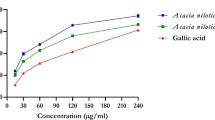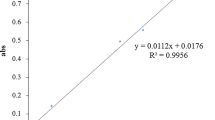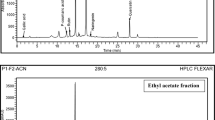Abstract
In the current study, we evaluated total phenolics, phenolic profile, and oxygen radical absorbance capacity (ORAC) of onion (Allium cepa L.). The inhibitory activity of onion extracts against porcine pancreatic α-amylase and rat intestinal α-glucosidase was also investigated. Ethyl alcohol extract of onion skin had the highest α-glucosidase inhibitory activity, ORAC value and total phenolic content, followed by water extract of skin, ethyl alcohol extract of pulp, and water extract of pulp. The α-glucosidase inhibitory activity of the extracts was compared to selected specific phenolics detected in the extracts using high performance liquid chromatography (HPLC). Quercetin, a major phenolic compound in onion extract had high α-glucosidase inhibitiory activity. The α-glucosidase inhibitory activity of the onion extracts correlated to the phenolic content and antioxidant activity of the extracts. These results suggest that onion which has high quercetin content has the potential to contribute as a dietary supplement for controlling hyperglycemia and oxidative stress-linked diabetes complications.
Similar content being viewed by others
References
Puls W, Keup U, Krause H, Thomas PG, Hoffmeister F. Glucosidase inhibition: A new approach to the treatment of diabetes, obesity, and hyperlipoproteinemia. Naturwissenschaften 64: 536–537 (1977)
Horii S, Fukasse K, Matsuo T, Kameda K, Asano N, Masui Y. Synthesis and α-d-glucosidase inhibitory activity of N-substituted valiolamine derivatives as potent oral antidiabetic agents. J. Med. Chem. 29: 1038–1046 (1987)
Bischoff H, Puls W, Krause HP, Schutt H, Thomas G. Pharmacological properties of the novel glucosidase inhibitors BAY m 1099 (miglitol) and BAY o 1248. Diabetes Res. Clin. Pr. 1: 53–63 (1983)
Puls W, Keup U. Metabolic studies with an amylase. Vol. 3, pp. 391–409. In: Recent Advances in Obesity Research. Howard A (ed). Newman Publisher, London, UK (1975)
Bischoff H. Pharmacology of glucosidase inhibitor. Eur. J. Clin. Invest. 24: 3–10 (1994)
Kwon Y-I, Vattem DA, Shetty K. Evaluation of clonal herbs of Lamiaceae species for management of diabetes and hypertension. Asia Pac. J. Clin. Nutr. 15: 107–118 (2005)
Brownlee M. The pathobiology of diabetic complications. Diabetes 54: 1615–1625 (2005)
Kaiser N, Sasson S, Feener EP, Boukobza N, Higashi S, Moller DE. Differential regulation of glucose transport and transporters by glucose in vascular endothelial and smooth muscle cells. Diabetes 42: 80–89 (1993)
Kawamura M, Heinecke JW, Chait A. Pathophysiological concentrations of glucose promote oxidative modification of low density lipoprotein by a superoxide dependent pathway. J. Clin. Invest. 94: 771–778 (1994)
Kim SJ, Kim GH. Quantification of quercetin in different parts of onion and its DPPH radical scavenging and antibacterial activity. Food Sci. Biotechnol. 15: 39–43 (2006)
Azuma K, Minami Y, Ippoushi K, Terao J. Lowering effects of onion intake on oxidative stress biomarkers in streptozotocin-induced diabetic rats. J. Clin. Biochem. Nutr. 40: 131–140 (2007)
EI-Demerdash FM, Yousef MI, Abou EI-Naga NI. Biochemical study on the hypoglycemic effects on onion and garlic in alloxaninduced diabetic rats. Food Chem. Toxicol. 43: 57–63 (2005)
Lee SK, Hwang JY, Kang MJ, Kim YM, Jung SH, Lee JH, Kim JI. Hypoglycemic effect of onion skin extract in animal models of diabetes mellitus. Food Sci. Biotechnol. 17: 130–134 (2008)
Griffiths G, Trueman L, Crowther T, Thomas B. Onions, a global benefit to health. Phytother. Res. 17: 603–615 (2002)
Rigelsky JM, Sweet BV. Hawthorn, pharmacology, and therapeutic uses. Am. J. Health-Syst. Ph. 59: 417–422 (2002)
Knekt P, Kumpulainen J, Järvinen R, Rissanen H, Heliövaara M, Reunanen A, Hakulinen T, Aromaa A. Flavonoid intake and risk of chronic diseases. Am. J. Clin. Nutr. 76: 560–568 (2002)
Shetty K, Curtis OF, Levin RE, Wikowsky R, Ang W. Prevention of verification associated with in vitro shoot culture of oregano (Origanum vulgare) by Pseudomonas spp. J. Plant Physiol. 147: 447–451 (1995)
Kurihara H, Fukami H, Asami S, Totoda Y, Nakai M, Shibata H, Yao XS. Effects of oolong tea on plasma antioxidative capacity in mice loaded with restraint stress assessed using the oxygen radical absorbance capacity (ORAC) assay. Biol. Pharm. Bull. 27: 1093–1098 (2004)
Cao G, Sofic E, Prior RL. Antioxidant and prooxidant behavior of flavonoids: Structure-activity relationships. Free Radical Bio. Med. 22: 749–760 (1997)
Kwon Y-I, Apostolidis E, Kim Y-C, Shetty K. Health benefits of traditional corn, beans, and pumpkin; In vitro studies for hyperglycemia and hypertension management. J. Med. Foods 10: 266–275 (2007)
Kim SH, Park JD, Lee LS, Han D. Effects of heat processing on the chemical composition of green tea extract. Food Sci. Biotechnol. 9: 214–217 (2000)
Robards K, Prenzler PD, Tucker G, Swatsitang P, Glover W. Phenolic compounds and their role in oxidative processes in fruits. Food Chem. 66: 401–436 (1999)
Kahkonen MP, Hopia AI, Vuorela HJ, Rauha J, Pihlaja K, Kujala TS, Heinonen M. Antioxidant activity of plant extracts containing phenolic compounds. J. Agr. Food Chem. 47: 3954–3962 (1999)
Kim D-S, Kwon HJ, Jang H-D, Kwon Y-I. In vitro α-glucosidase inhibitory potential and antioxidant activity of selected Lamiaceae species inhabited in Korean peninsula. Food Sci. Biotechnol. 18: 239–244 (2009)
Gao H, Kawabata J. Importance of the B ring and its substitution on the α-glucosidase inhibitory activity of baicalein, 5,6,7-trihydroxyflavone. Biosci. Biotech. Bioch. 68: 1858–1864 (2004)
Tadera K, Minami Y, Takamatsu K, Matsuoka T. Inhibition of α-glucosidase and α-amylase by flavonoids. J. Nutr. Sci. Vitaminol. 52: 149–153 (2006)
Hertog MGL, Kromhout D, Aravanis C, Blacburn H, Buzina R, Fridanza F, Giampaoli S, Jansen A, Menotti A, Nedeljkovic S, Pekkarinen M, Simic BS, Toshima H, Feskens EJM, Hollman PCH, Kattan MB. Flavonoid intake and long-term risk of coronary heart disease and cancer in the seven counties study. Arch. Int. Med. 155: 381–386 (1995)
Paganga G, Miller N, Rice-Evans CA. The polyphenolic contents of fruits and vegetables and their antioxidant activities. What does a serving constitute? Free Radical Res. 30: 153–162 (1999)
Block G, Patterson B, Subar A. Fruit, vegetables, and cancer prevention: A review of the epidemiological evidence. Nutr. Cancer 18: 1–29 (1992)
Author information
Authors and Affiliations
Corresponding author
Rights and permissions
About this article
Cite this article
Kim, MH., Jo, SH., Jang, HD. et al. Antioxidant activity and α-glucosidase inhibitory potential of onion (Allium cepa L.) extracts. Food Sci Biotechnol 19, 159–164 (2010). https://doi.org/10.1007/s10068-010-0022-1
Received:
Revised:
Accepted:
Published:
Issue Date:
DOI: https://doi.org/10.1007/s10068-010-0022-1




